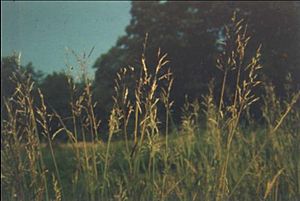Bothriochloa bladhii facts for kids
Quick facts for kids Bothriochloa bladhii |
|
|---|---|
 |
|
| Scientific classification | |
| Genus: |
Bothriochloa
|
| Species: |
bladhii
|
| Synonyms | |
|
|
Bothriochloa bladhii is a type of grass that has many common names, like Australian bluestem, Caucasian bluestem, forest-bluegrass, plains bluestem, and purple plume grass. It belongs to the Poaceae family, which is the grass family.
This grass is mostly found in warm, tropical parts of Africa, Asia, and Australia. It also grows in some cooler, temperate areas of Asia. The very first sample of this plant that scientists studied was collected in China. It was found by a Finnish botanist named Peter Johan Bladh, and the plant's scientific name, bladhii, honors him!
Contents
Where Does Bothriochloa Bladhii Grow?
Bothriochloa bladhii is a very widespread grass. It grows naturally across many different continents and regions.
Native Homes of This Grass
You can find this grass in many parts of:
- Africa: It grows in countries like Angola, Botswana, Ethiopia, Kenya, Nigeria, South Africa, and Tanzania.
- Asia: It's common in tropical and temperate areas, including China (in provinces like Anhui and Yunnan), India, Japan, Malaysia, Nepal, and Thailand.
- Eurasia: It's also found in parts of eastern Eurasia, such as Armenia, Azerbaijan, and southern Kazakhstan.
- Middle East: Countries like Afghanistan and Iran are also home to this grass.
- Australia: In Australia, it grows in states like New South Wales, Queensland, and Western Australia.
Where Else Has It Spread?
Besides its native homes, Bothriochloa bladhii has also started growing in other places where it wasn't originally found. These areas are mostly in the Neotropics, which includes parts of Central and South America. When a plant starts growing in a new area on its own, it's called being naturalized.
How Is Bothriochloa Bladhii Used?
This grass is quite useful, especially for animals and for helping land recover.
Food for Animals
One of its main uses is as food for animals.
- Livestock: Farmers use Bothriochloa bladhii as fodder, which means it's cut and stored to feed animals like cows and sheep later.
- Grazing: Both farm animals and wild animals, like ruminants (animals that chew their cud, such as deer), eat this grass by grazing directly on it.
Helping Land Recover
Sometimes, land can get damaged or "disturbed" by things like construction or natural events. Bothriochloa bladhii is sometimes planted to help restore these disturbed areas. It helps new plants grow and makes the land healthy again.

